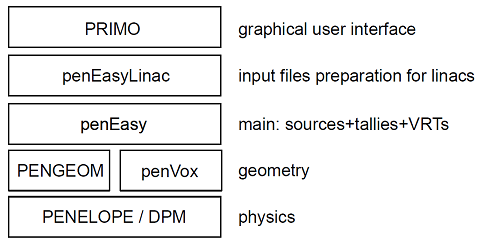Articles describing PRIMO
Full Monte Carlo dose verification system for external beam radiotherapy
Widely used in the routine clinical practice, research and education
- The reference publication for PRIMO is:
- M. Rodriguez, J. Sempau and L. Brualla, PRIMO: A graphical environment for the Monte Carlo simulation of Varian and Elekta linacs, Strahlenther. Onkol. 189 (2013) 881-886. Available here.
- We kindly ask researchers to cite this work in their scientific papers to refer to PRIMO.

- A review article on Monte Carlo systems used for treatment planning and dose verification in external beam radiotherapy with linacs has been published:
PRIMO is a layered software system. The following diagram shows its components.

- Articles about PENELOPE
- F. Salvat, J. M. Fernández-Varea and J. Sempau, PENELOPE 2011: A code system for Monte Carlo simulation of electron and photon transport, OECD Nuclear Energy Agency, Issy-les-Moulineaux, France, 2011. Available here (NEA web page).
- J. Sempau, E. Acosta, J. Baró, J. M. Fernández-Varea and F. Salvat, An algorithm for Monte Carlo simulation of coupled electron-photon transport, Nucl. Instrum. Meth. B 132 (1997) 377–390. Available here.
- J. Baró, J. Sempau, J. M. Fernández-Varea and F. Salvat, PENELOPE: an algorithm for Monte Carlo simulation of the penetration and energy loss of electrons and positrons in matter, Nucl. Instrum. Meth. B 100 (1995) 31–46. Available here.
- Starting from version 0.3.1.1600, PRIMO allows the simulation of the radiation transport in the patient dependent part of the linac and in the computerized tomography with the fast Monte Carlo code Dose Planning Method (DPM). PRIMO Includes a parallelized version of DPM. The publications related to DPM are:DPM available here.
- J. Sempau, S. J. Wilderman and A. F. Bielajew, DPM, a fast, accurate Monte Carlo code optimized for photon and electron radiotherapy treatment planning dose calculations, Phys. Med. Biol. 45 (2000) 2263–2291.Available here.
- M. Rodriguez and L. Brualla, Many-integrated core (MIC) technology for accelerating Monte Carlo simulation of radiation transport: A study based on the code DPM, Comput. Phys. Commun. 225 (2018) 28-35. Available here.
- M. Rodriguez, J. Sempau, C. Bäumer, B. Timmermann and L. Brualla, DPM as a radiation transport engine for PRIMO. Radiat. Oncol. 13 (2018) 256. Available here.
- The geometry layer contains PENGEOM, which is included in the PENELOPE distribution and described in its documentation, and penVox, which is now part of penEasy. The next two upper layers are based on the penEasy code, a general-purpose main program for PENELOPE, and penEasyLinac, a code that prepares the linac geometry and input files for penEasy. Available here.
- The penEasy reference is:
- J. Sempau, A. Badal and L. Brualla, A PENELOPE-based system for the automated Monte Carlo simulation of clinacs and voxelized geometries—application to far-from-axis fields, Med. Phys. 38 (2011) 5887–5895. Available here.
- The uppermost layer is described in the reference paper for PRIMO (see above).
- A number of other publications related with particular aspects of PRIMO, most notably with the variance-reduction techniques implemented in the code at various layer levels, are listed below in reverse chronological order:
- M. Rodriguez, J. Sempau, and L. Brualla. Monte Carlo simulation of the Varian TrueBeam flattened-filtered beams using a surrogate geometry in PRIMO. Radiat. Oncol. 19, 14 (2024).Available here.
- M. Rodriguez, J. Sempau, A. Fogliata, L. Cozzi, W. Sauerwein and L. Brualla, A geometrical model for the Monte Carlo simulation of the TrueBeam linac, Phys. Med. Biol. 60 (2015) N219–N229.Available here.
- M. Rodriguez, J. Sempau and L. Brualla, Technical Note: Study of the electron transport parameters used in PENELOPE for the Monte Carlo simulation of Linac targets, Phys. Med. Biol. 42 (2015) 2877–2881. Available here.
- M.F. Belosi, M. Rodriguez, A. Fogliata et al., Monte Carlo simulation of TrueBeam flattening-filter-free beams using Varian phase-space files: Comparison with experimental data, Med. Phys. 41 (2014) 051707. Available here.
- M. Rodriguez, J. Sempau and L. Brualla, A combined approach of variance-reduction techniques for the efficient Monte Carlo simulation of linacs, Phys. Med. Biol. 57 (2012) 3013–3024. Available here.
- L. Brualla, Simulation of medical linear accelerators with PENELOPE. On "Radiation damage in biomolecular systems", Eds. G. García Gómez-Tejedor, M. C. Fuss. Springer, 2012.
- L. Brualla and W. Sauerwein, On the efficiency of azimuthal and rotational splitting for Monte Carlo simulation of clinical linear accelerators, Rad. Phys. Chem. 79 (2010) 929–932. Available here.
- L. Brualla, F. Salvat and R. Palanco-Zamora, Efficient Monte Carlo simulation of multileaf collimators using geometry-related variance-reduction techniques, Phys. Med. Biol. 54 (2009) 4131–4149. Available here.
- A. Badal and J. Sempau, A package of Linux scripts for the parallelization of Monte Carlo simulations, Comput. Phys. Commun. 175 (2006), 440–450. Available here.
- J. Sempau, A. Sánchez-Reyes, F. Salvat, H. Oulad ben Tahar, S. B. Jiang and J. M. Fernández-Varea, Monte Carlo simulation of electron beams from an accelerator head using PENELOPE, Phys. Med. Biol. 46 (2001) 1163–1186. Available here.
More papers related to PRIMO can be found in the thematic series published the by the journal Radiation Oncology, entitled: ‘The Monte Carlo radiotherapy system PRIMO: Dosimetry and treatment planning research problems’. Available here
